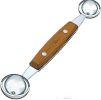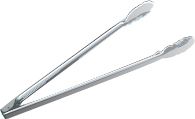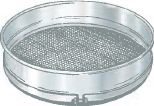Advertisement
Hand Tools and Small Equipment
Published 2014
Ball cutter, melon ball scoop, or parisienne knife.
The blade is a small, cup-shaped half-sphere. Used for cutting fruits and vegetables into small balls.
Parisienne melon baller
Cook’s fork.
A heavy, two-pronged fork with a long handle. Used for lifting and turning meats and other items. Must be strong enough to hold heavy loads.
Cook’s fork
Straight spatula or palette knife.
A long, flexible blade with a rounded end. Used mostly for spreading icing on cakes and for mixing and bowl scraping.
Straight spatula
Sandwich spreader.
A short, stubby spatula. Used for spreading fillings and spreads on sandwiches.
Sandwich spreader
Offset spatula.
A broad blade, bent to keep the hand off hot surfaces. Used for turning and lifting eggs, pancakes, and meats on griddles, grills, sheet pans, and so on. Also used as a scraper to clean benches and griddles.
Offset spatula
Rubber spatula or scraper.
A broad, flexible rubber or plastic tip on a long handle. Used to scrape bowls and pans. Also used for folding in egg foams and whipped cream. Heat-resistant spatulas can be used for stirring foods while cooking, but regular spatulas will melt at high heat.
Rubber spatula
Pie server.
A wedge-shaped offset spatula. Used for lifting pie wedges from pan.
Pie server
Bench scraper or dough knife.
A broad, stiff piece of metal with a wooden handle on one edge. Used to cut pieces of dough and to scrape workbenches.
Bench scraper
Pastry wheel or wheel knife.
A round, rotating blade on a handle. Used for cutting rolled-out doughs and pastry and baked pizza.
Pastry wheel
Spoons: slotted, perforated, and solid.
Large stainless-steel spoons that hold about 3 ounces (90 mL). Used for stirring, mixing, and serving. Slotted and perforated spoons are used when liquid must be drained from solids.
Spoons: slotted, perforated, solid
Skimmer.
A perforated disk, slightly cupped, on a long handle. Used for skimming froth from liquids and for removing solid pieces from soups, stocks, and other liquids. Wire mesh versions are sometimes called spiders.
Skimmer
Tongs.
Spring-type or scissors-type tools used to pick up and handle foods.
Tongs
Wire mesh skimmer or spider
Wire whip.
Loops of stainless-steel wire fastened to a handle. There are two kinds of whips (also called whisks):
- Heavy whips are straight, stiff, and have relatively few wires. Used for general mixing, stirring, and beating, especially heavy liquids.
- Balloon whips, or piano-wire whips, have many flexible wires. Used for whipping eggs, cream, and hollandaise, and for mixing thinner liquids.
Wire whip
China cap.
A cone-shaped strainer. Used for straining stocks, soups, sauces, and other liquids. Pointed shape allows the cook to drain liquids through a relatively small opening.
China cap
Fine china cap or chinois (shee-nwah).
A china cap with very fine mesh. Used when great clarity or smoothness is required in a liquid.
Chinois
Strainer.
A round-bottomed, cup-shaped tool made of screen-type mesh or perforated metal. Used for straining pasta, vegetables, and so on.
Strainer
Wire mesh strainer
Drum sieve or tamis.
A screen-type mesh supported in a round metal frame. Used for sifting flour and other dry ingredients and for puréeing soft foods.
Sieve
Colander.
A large, perforated bowl made of stainless steel or aluminum. Used to drain washed or cooked vegetables, salad greens, pasta, and other foods.
Colander
Food mill.
A tool with a hand-turned blade that forces foods through a perforated disk. Interchangeable disks produce varying degrees of coarseness or fineness. Used for puréeing foods.
Food mill
Grater.
A four-sided metal box with grids of varying sizes. Used for shredding and grating vegetables, cheese, citrus rinds, and other foods.
Grater
Plane grater.
Usually known by the brand name Microplane. These graters shave off thin shreds of the item being grated, the way a carpenter’s plane shaves wood. Available in varying degrees of fineness or coarseness.
Microplane
Zester.
A small hand tool used for removing the colored part of citrus peels in thin strips.
Zester
Channel knife.
A small hand tool used mostly in decorative work.
Channel knife
Mandoline.
A manual slicing implement consisting of blades fitted in a flat metal or wood framework. Folding legs position the mandoline on the worktable at a 45-degree angle for use. Levers allow the blades to be adjusted to control the thickness of the slices. A traditional mandoline has a flat blade and a serrated blade. Additional blades can be used in combination with the flat blade to cut julienne and bâtonnet. The serrated blade is used to cut gaufrette or waffle slices.
Mandoline
For safest use, a detachable guard is also supplied. The guard holds the food and allows it to be sliced without getting the fingers near the blades.
Pastry bag and tubes.
Cone-shaped cloths or plastic bags with an open end that can be fitted with metal tubes or tips of various shapes and sizes. Used for shaping and decorating with items such as cake icing, whipped cream, duchesse potatoes, and soft dough. Disposable plastic pastry bags are the most sanitary.
Pastry bag and tubes
Pastry brush.
Used to brush items with egg wash, glaze, etc.
Pastrybrush
Can opener.
Heavy-duty can openers are mounted on the edge of the workbench. They must be carefully cleaned and sanitized every day to prevent contamination of foods. Replace worn blades, which can leave metal shavings in the food.
Can opener






























